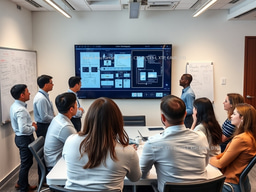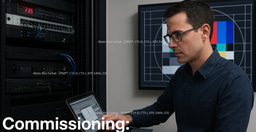Conferencing and Hybrid Workspaces ( Multi-Modal Real-Time Collaboration Frameworks for Hybrid Work Environments)

Multi-Modal Real-Time Collaboration Frameworks for Hybrid Work Environments.
The Audio-Visual (AV) industry plays a pivotal role in shaping modern conferencing and hybrid workspaces by leveraging technology to facilitate seamless communication and collaboration.
Kindly refer to the following key technical aspects and trends within the AV industry related to conferencing and hybrid workspaces:
1- High-Quality Audiovisual Solutions: AV technology delivers high-definition video and crystal-clear audio, utilizing advanced codecs, high-resolution cameras, and professional-grade microphones, speakers, and sound systems.
2- Unified Communications and Collaboration (UC&C) Platforms: AV systems integrate with UC&C platforms such as Zoom Rooms, Microsoft Teams Rooms, and Cisco Webex, providing a seamless user experience with video conferencing, messaging, file sharing, and collaboration tools.
3- Room Design and Integration: Meeting spaces are designed to cater to both in-person and remote participants, incorporating interactive displays, touch panels for control, intelligent cameras, and connectivity hubs to support multiple devices.
4- Network Infrastructure and Security: Robust network infrastructure supports bandwidth-intensive video conferencing, with AV specialists optimizing networks, implementing Quality of Service (QoS) measures, and applying security protocols for smooth and secure data transmission.
5- Remote Monitoring and Management: AV systems incorporate remote monitoring and management capabilities, enabling technicians to troubleshoot issues, perform updates, and maintain equipment remotely.
6- Adaptation to Hybrid Work Models: AV technology evolves to cater to the changing demands of hybrid work, including innovations in AI-driven collaboration tools, augmented reality (AR) for immersive experiences, and flexible hardware setups.
7- Interoperability and Standards: AV professionals ensure different systems can communicate effectively, minimizing compatibility issues through interoperability and adherence to industry standards.
8- AI and Automation: AI is integrated into AV systems for automated camera framing, speaker tracking, background noise suppression, and analytics to optimize meeting room usage and resource allocation.
9- Immersive Technologies: AV professionals explore incorporating augmented reality (AR) and virtual reality (VR) into conferencing solutions to create engaging and interactive meeting experiences.
10- Cloud-Based Solutions: Cloud-based AV solutions offer scalability, flexibility, and easy deployment, supporting remote management, updates, and scalability across multiple locations.
11- Enhanced Accessibility: AV tools include features such as live transcription, real-time translation, and support for assistive technologies, ensuring inclusivity for all participants.
12- Cybersecurity Measures: AV professionals implement robust encryption, authentication protocols, and secure data transmission practices to safeguard sensitive information shared during conferences.
13- Eco-Friendly Solutions: The AV industry promotes sustainability through energy-efficient equipment design and environmentally friendly practices in production and disposal.
14- Customization and Integration: AV specialists create custom solutions tailored to specific client needs, integrating AV systems with existing infrastructure.
15- IoT and Smart Spaces: AV systems integrate with IoT devices to create smart meeting spaces, enhancing room automation, scheduling, and resource utilization.
16- 5G Integration: 5G technology revolutionizes AV conferencing with high bandwidth and low latency, enabling seamless transmission of high-quality video and audio.
17- Edge Computing: AV systems leverage edge computing to reduce latency and enhance real-time processing, improving applications like virtual collaboration tools.
18- Remote Work Ergonomics: AV professionals optimize remote work setups, providing guidance on ergonomic home office setups, lighting, acoustics, and recommending suitable AV equipment.
19- Environmental Sensing and Adaptive AV: AV setups incorporate environmental sensors to automatically adjust lighting, temperature, and audio levels based on occupancy and ambient conditions, creating comfortable and productive meeting environments.
The AV industry is continuously evolving to meet the demands of modern conferencing and hybrid workspaces. Through advancements in AI, immersive technologies, cloud-based solutions, enhanced accessibility, cybersecurity measures, eco-friendly practices, customization and integration, IoT and smart spaces, 5G integration, edge computing, remote work ergonomics, and adaptive AV, AV professionals strive to create environments that
-
Xchange Advocates are recognized AV/IT industry thought leaders and influencers. We invite you to connect with them and follow their activity across the community as they offer valuable insights and expertise while advocating for and building awareness of the AV industry.
Recommended Content
LetsTalkAVbyAlexis Series: Episode 4 : Design Begins With People: Engineering AV Systems Around Real End-User Requirements

LetsTalkAVbyAlexis Series : Episode 2: Network & AV Convergence (AVoIP)





Please sign in or register for FREE
If you are a registered user on AVIXA Xchange, please sign in